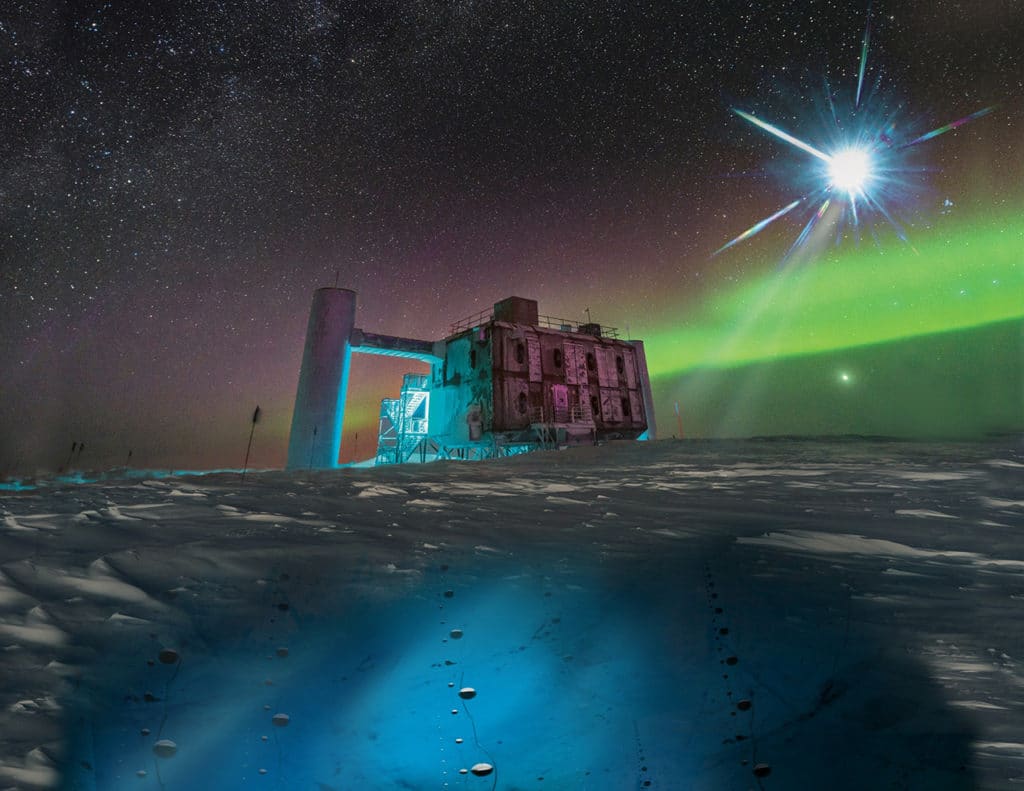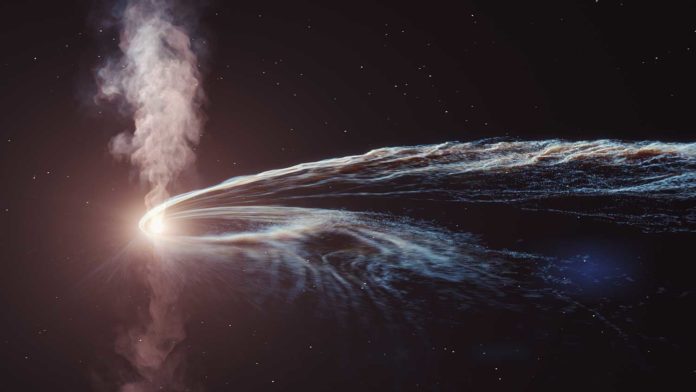Neutrinos give an extraordinary view into the generally hidden mechanism of particle acceleration in astrophysical objects. The IceCube Collaboration recently revealed the possible relationship of one high-energy neutrino with a flare from the relativistic jet of an active galaxy pointed towards the Earth.
Recently scientists at ICRAR traced back neutrino to such a ‘tidal disruption event’ (TDE). The team reported that these little-understood cosmic catastrophes could be powerful natural particle accelerators.
The subatomic particle, called a neutrino, was hurled towards Earth after the doomed star came too close to the supermassive black hole at the center of its home galaxy and was ripped apart by the black hole’s colossal gravity.
This study helps scientists understand the power of exploring the cosmos using a combination of various ‘messengers’ such as photons (the particles of light) and neutrinos, also known as multi-messenger astronomy.
Co-author Marek Kowalski, head of neutrino astronomy at DESY and a professor at Humboldt University in Berlin, said, “The combined observations demonstrate the power of multi-messenger astronomy. Without the detection of the tidal disruption event, the neutrino would be just one of many. And without the neutrino, the observation of the tidal disruption event would be just one of many. Only through the combination could we find the accelerator and learn something new about the processes inside.”
The neutrino that scientists traced was traveling 700 million years from the far-away, unnamed galaxy in the constellation Delphinus (the Dolphin) to finally arrive at the IceCube neutrino detector at the South Pole. According to scientists, the supermassive black hole that launched this neutrino must be as massive as 30 million suns.

Lead author Robert Stein, DESY scientist, said, “The force of gravity gets stronger and stronger, the closer you get to something. That means the black hole’s gravity pulls the star’s near side more strongly than the star’s far side, leading to a stretching effect. This difference is called a tidal force, and as the star gets closer, this stretching becomes more extreme. Eventually, it rips the star apart, and then we call it a tidal disruption event. It’s the same process that leads to ocean tides on Earth, but luckily for us, the moon doesn’t pull hard enough to shred the Earth.”
On 1 October 2019, the IceCube neutrino detector at the South Pole registered an extremely energetic neutrino from the direction of the tidal disruption event. The extremely lightweight neutrinos hardly interact with anything, pass unnoticed through not just walls but whole planets or stars, and are often referred to as ghost particles.
Scientists noted, “Even catching just one high-energy neutrino is already a remarkable observation. The detection prompted further observations of the event with many instruments across the electromagnetic spectrum, from radio waves to X-rays.”
ICRAR-Curtin’s Professor James Miller said, “Not all tidal disruption events seem to produce such energetic outflows. Therefore, the radio detection of this event provided important evidence that it was likely the source of the neutrino.”
Lead author Robert Stein explains that “This is the first neutrino linked to a tidal disruption event, and it brings us valuable evidence. Tidal disruption events are not well understood. The neutrino detection points to the existence of a central, powerful engine near the accretion disc, spewing out fast particles. And the combined analysis of data from radio, optical and ultraviolet telescopes gives us additional evidence that the TDE acts as a gigantic particle accelerator.”
Francis Halzen, Professor at the University of Wisconsin-Madison and Principal Investigator of IceCube, who was not directly involved in the study, said, “We might only be seeing the tip of the iceberg here. In the future, we expect to find many more associations between high-energy neutrinos and their sources. A new generation of telescopes will be built that will provide greater sensitivity to TDEs and other prospective neutrino sources. Even more essential is the planned extension of the IceCube neutrino detector, that would increase the number of cosmic neutrino detections at least tenfold.”
Professor Miller-Jones said, “It’s fascinating for the radio astronomy expertise of Australian-based astronomers to be instrumental in uncovering these new insights into the high-energy Universe. The huge leap in sensitivity provided by the Square Kilometre Array will allow detailed studies of more of these cataclysmic events. This will provide critical new insights into the workings of black holes.”
The IceCube Neutrino Observatory is a facility of the U.S. National Science Foundation operated at the Amundsen-Scott South Pole Station under the U.S. Antarctic Program. Apart from IceCube and ZTF, the instruments Spectral Energy Distribution Machine (SEDM), Palomar 200-inch Hale Telescope (P200), Liverpool Telescope (LT), NASA’s Neil Gehrels Swift Observatory, Lowell Discovery Telescope, Lick Observatory Shane Telescope, Keck Telescope, ESA’s X-ray Multi-Mirror Mission (XMM-Newton), Karl G. Jansky Very Large Array (VLA), AMI Large Array (AMI-LA), MeerKAT, and NASA’s Fermi Large Area Telescope (Fermi-LAT) provided observational data for the study.
Journal Reference:
- Robert Stein, Sjoert van Velzen, Marek Kowalski, et al. A tidal disruption event coincident with a high-energy neutrino. Nature Astronomy, 2021, DOI: 10.1038/s41550-020-01295-8
